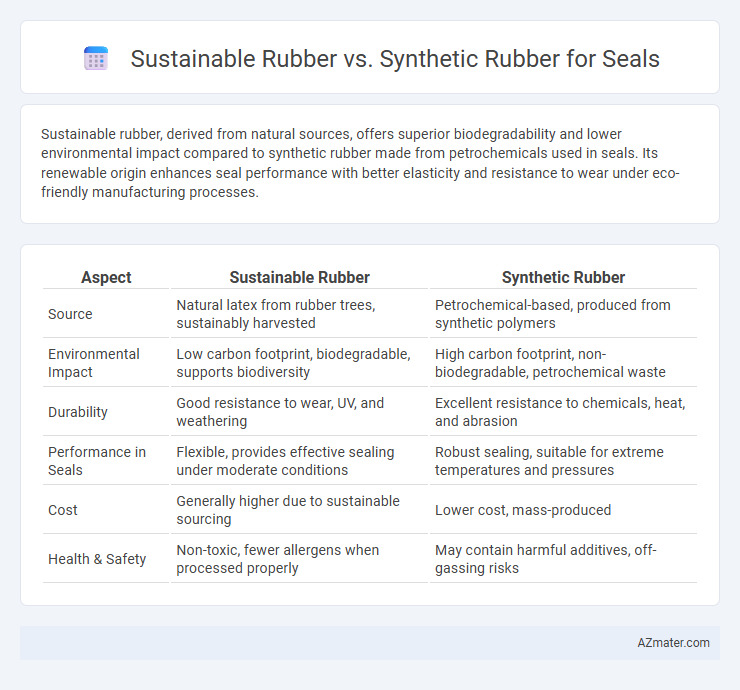Sustainable rubber, derived from natural sources, offers superior biodegradability and lower environmental impact compared to synthetic rubber made from petrochemicals used in seals. Its renewable origin enhances seal performance with better elasticity and resistance to wear under eco-friendly manufacturing processes.
Table of Comparison
| Aspect | Sustainable Rubber | Synthetic Rubber |
|---|---|---|
| Source | Natural latex from rubber trees, sustainably harvested | Petrochemical-based, produced from synthetic polymers |
| Environmental Impact | Low carbon footprint, biodegradable, supports biodiversity | High carbon footprint, non-biodegradable, petrochemical waste |
| Durability | Good resistance to wear, UV, and weathering | Excellent resistance to chemicals, heat, and abrasion |
| Performance in Seals | Flexible, provides effective sealing under moderate conditions | Robust sealing, suitable for extreme temperatures and pressures |
| Cost | Generally higher due to sustainable sourcing | Lower cost, mass-produced |
| Health & Safety | Non-toxic, fewer allergens when processed properly | May contain harmful additives, off-gassing risks |
Introduction to Rubber Seals: Sustainable vs Synthetic
Rubber seals play a critical role in preventing leaks and maintaining pressure in various industrial applications. Sustainable rubber, derived from natural latex harvested from rubber trees, offers eco-friendly benefits such as biodegradability and reduced carbon footprint compared to synthetic rubber, which is produced from petroleum-based polymers like styrene-butadiene. Choosing between sustainable and synthetic rubber seals depends on factors like environmental impact, durability, and chemical resistance required for specific sealing applications.
Key Differences: Sustainable Rubber and Synthetic Rubber
Sustainable rubber, derived from renewable natural sources like Hevea brasiliensis trees, offers biodegradability and lower environmental impact compared to petroleum-based synthetic rubber. Synthetic rubber, produced through chemical polymerization of monomers such as styrene and butadiene, provides superior consistency, durability, and resistance to extreme temperatures and chemicals. Key differences include sustainability credentials, carbon footprint, and performance attributes tailored to specific sealing applications in industries like automotive and aerospace.
Environmental Impact of Rubber Seal Materials
Sustainable rubber seals significantly reduce environmental impacts by utilizing renewable natural latex harvested from rubber trees, which supports carbon sequestration and minimizes reliance on fossil fuels. Synthetic rubber seals, derived from petrochemicals, contribute to higher greenhouse gas emissions and generate non-biodegradable waste, intensifying landfill pressures. Choosing sustainable rubber materials for seals promotes eco-friendly disposal and decreased environmental pollution compared to synthetic alternatives.
Performance and Durability Comparison
Sustainable rubber, derived from natural latex, offers superior elasticity and excellent resistance to abrasion, making it ideal for seals requiring flexibility and durability in dynamic applications. Synthetic rubber, such as nitrile or silicone, provides enhanced chemical resistance and stability under extreme temperatures, outperforming natural rubber in harsh industrial environments. Performance-wise, sustainable rubber excels in biodegradability and environmental impact, while synthetic variants deliver longer lifespan and consistent sealing efficiency in specialized conditions.
Production Process: Natural vs Synthetic Rubber
Sustainable rubber, derived from natural latex harvested from rubber trees, undergoes a production process that emphasizes eco-friendly tapping methods and biodegradable chemicals, reducing environmental impact and promoting renewability. In contrast, synthetic rubber is produced through the polymerization of petroleum-based monomers such as styrene and butadiene, involving energy-intensive chemical processes that generate greenhouse gas emissions and rely on finite fossil fuel resources. For seals, natural rubber offers superior elasticity and biodegradability, while synthetic rubber provides greater resistance to oils and extreme temperatures but with a higher environmental footprint.
Cost Considerations for Manufacturers
Sustainable rubber, derived from renewable natural sources such as Hevea brasiliensis, often incurs higher upfront costs due to limited supply chain infrastructure and more labor-intensive harvesting compared to synthetic rubber made from petroleum-based feedstocks. Manufacturers face fluctuating price stability with sustainable rubber influenced by climate and geopolitical factors, whereas synthetic rubber offers consistent pricing and large-scale production advantages. Despite higher initial expenses, sustainable rubber can reduce long-term costs through biodegradability and compliance with increasing environmental regulations, making it economically viable for eco-conscious seal manufacturing.
Applications: Which Rubber Type Suits Your Needs?
Sustainable rubber, sourced from natural latex, excels in applications requiring biodegradability, flexibility, and resistance to heat, making it ideal for automotive seals, medical devices, and environmentally conscious products. Synthetic rubber, engineered from petrochemicals like styrene-butadiene or neoprene, offers superior chemical resistance, durability, and performance in extreme temperatures, preferred in industrial seals, oil and gas equipment, and heavy machinery. Choosing between sustainable and synthetic rubber depends on factors such as environmental impact, mechanical requirements, and exposure conditions in your specific sealing application.
Regulatory and Industry Standards
Sustainable rubber complies with emerging regulatory frameworks such as the European Union's REACH and the U.S. EPA's TSCA, which emphasize reduced environmental impact and material traceability, whereas synthetic rubber often faces stricter scrutiny due to its petroleum-based origin and associated emissions. Industry standards like ISO 14001 and ASTM D2000 increasingly prioritize sustainable sourcing and lifecycle assessments, encouraging manufacturers to adopt eco-friendly materials for seals. Certification programs such as the Forest Stewardship Council (FSC) for natural rubber highlight compliance with sustainable harvesting, providing a competitive advantage over synthetic alternatives in eco-conscious markets.
Future Trends in Rubber Seal Materials
Sustainable rubber, derived from natural sources like Hevea brasiliensis, is gaining traction in rubber seal applications due to its biodegradability, lower carbon footprint, and improved mechanical properties through advanced compounding techniques. Synthetic rubber variants such as EPDM and NBR continue evolving with enhanced oil resistance, temperature stability, and customizable formulations to meet stringent industry standards. Future trends emphasize hybrid materials combining sustainable natural rubber with synthetic elements to optimize durability, environmental impact, and cost-effectiveness in sealing technologies.
Choosing the Right Rubber Seal: Sustainability vs Performance
Sustainable rubber seals, made from natural latex or recycled materials, offer eco-friendly benefits such as biodegradability and lower carbon footprints, making them ideal for environmentally conscious applications. Synthetic rubber seals, including nitrile and silicone, provide superior performance in terms of chemical resistance, temperature tolerance, and durability, essential for demanding industrial environments. Choosing the right rubber seal requires balancing sustainability goals with specific performance requirements such as elasticity, wear resistance, and operational lifespan.

Infographic: Sustainable rubber vs Synthetic rubber for Seal
 azmater.com
azmater.com